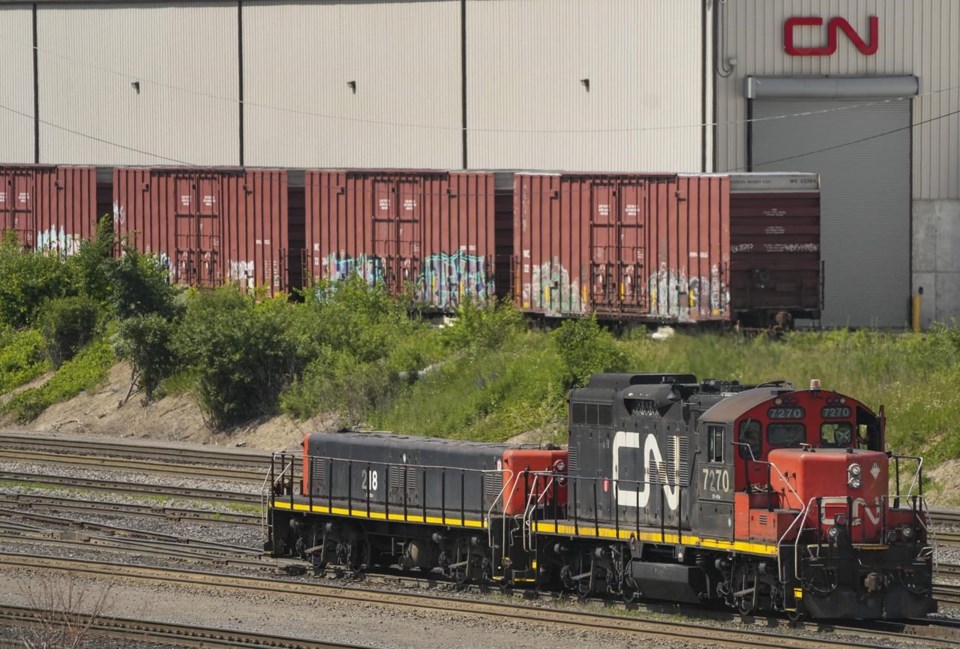MONTREAL — A stable economic outlook and rising cargo demand bode well for Canadian National Railway Co. this year, executives said, despite the Red Sea crisis dampening container figures on the East Coast.
“We’re seeing momentum building,” CEO Tracy Robinson told analysts on a conference call Tuesday. “The team is gelling, the operation is performing and volumes are on the upswing.”
Revenue dipped by one per cent year over year to $4.25 billion in CN's first quarter. Diluted earnings hit $1.72 per share, roughly on par with analysts' expectations, according to LSEG Data & Analytics.
“This is right where we thought we’d be after three months,” Robinson said.
In spite of a nearly 10-per-cent year-over-year drop in net income, the country's largest railroad operator reiterated its forecast of earnings per share growth of 10 per cent this year — the bulk of it coming in the second half of 2024 — and capital spending of about $3.5 billion.
The upbeat notes also come despite ongoing discord in the Red Sea, where attacks on cargo vessels have prompted a wholesale shift in global shipping.
The ongoing missile strikes by Iran-backed Houthi militants in Yemen have pushed major container carriers to steer clear of the area. Since mid-December, hundreds of vessels have sailed around the tip of Africa instead of passing through the Suez Canal, tacking on major fuel and crew expenses and triggering a spike in freight rates.
The longer travel time and scrambled schedules have resulted in delays of up to three weeks on scores of ships slated to roll into the Port of Halifax — a key hub for CN — over the past few months. Roughly two-thirds of the 40 ships scheduled to arrive between April 8 and the end of the month will berth at least three days late, with some more than 21 days overdue, according to the port's vessel forecast.
Other ships are choosing to avoid the Halifax and Montreal ports altogether, offloading U.S.-bound goods at American ports instead due partly to their greater proximity to the Cape of Good Hope, CN executives said.
"They (face) more of an impact because of the Suez Canal," said chief marketing officer Doug MacDonald of the two ports.
"We're seeing it a little bit down at Halifax, a little bit down at Montreal because of all that. And we're just hoping that that will come back once that issue in the world gets cleared up."
The crisis has also pushed many shippers that had recently switched to the Suez Canal to return to transpacific routes between Asia and North America, after abandoning them due in part to bottlenecks at the Panama Canal. A Central American drought has prompted backups at the passage, which needs vast amounts of water to raise and lower ships at a dozen locks.
On Canada's West Coast, container import volumes for CN rose 12 per cent year over year as traffic returned to Vancouver and Prince Rupert after last summer's strike by 7,400 B.C. dockworkers.
Nonetheless, analyst Ravi Shanker of Morgan Stanley called CN's optimism "surprisingly bullish" on the conference call, contrasting it with other transport companies' forecasts.
Robinson replied by pointing to rising industrial production figures: “It does give us some confidence in a lift in the underlying economy.”
She also cited "CN-specific growth initiatives" as cause for high expectations.
Demand for commodities ranging from lumber to coal and grain is on the rise, with international container and automotive volumes poised to increase as well, the company said.
One hurdle is congestion at the Vancouver port, which along with Red Sea disruptions helps account for a nearly 10-per-cent decline last quarter in container revenues — CN's biggest segment — even as demand starts to surge back.
“All marine terminals in Vancouver continue to manage through heavy congestion, resulting from an inadequate supply of rail cars from major Class 1 railways," read a note to customers from German shipping giant Hapag-Lloyd in late March.
"For CN, the congestion at the port is increasing."
Lower prices on domestic container hauls due to overcapacity in trucking, a rival sector where rates have dipped, also drove some of the revenue decrease, CN executives said.
All its segments dipped or remained flat in the first quarter compared with a year earlier, except for petroleum and chemicals, which enjoyed a four-per-cent revenue boost.
The Montreal-based company reported that net income fell to $1.10 billion in the three months ended March 31 from $1.22 billion in the same period a year earlier, amid higher labour costs — head count rose three per cent and wages climbed as well — and the lower container revenue.
CN's board approved a second-quarter dividend of 84.5 cents per share that will be paid on June 28.
This report by The Canadian Press was first published April 23, 2024.
Companies in this story: (TSX:CNR)
Christopher Reynolds, The Canadian Press




